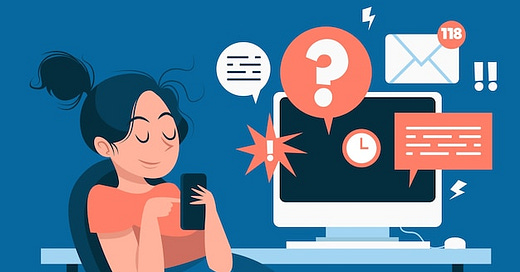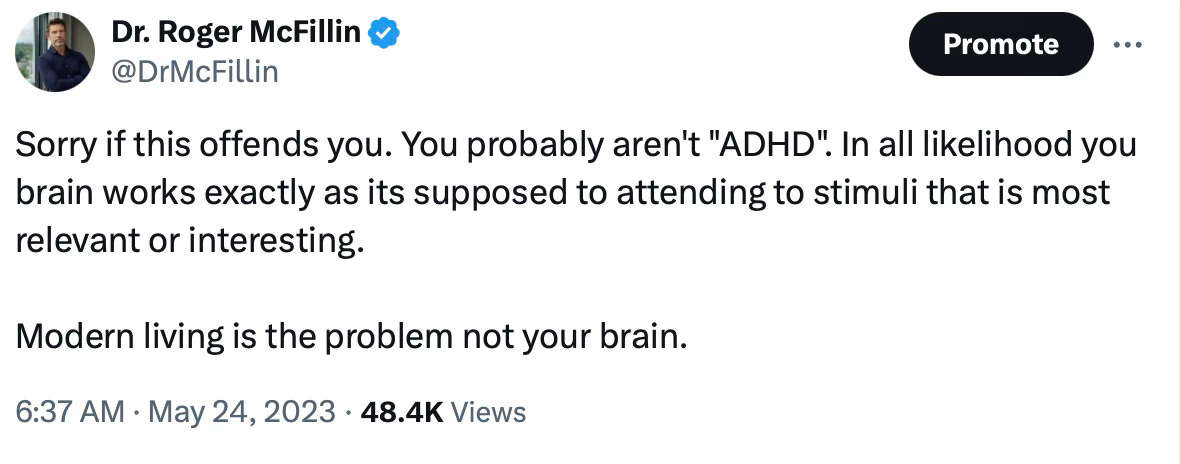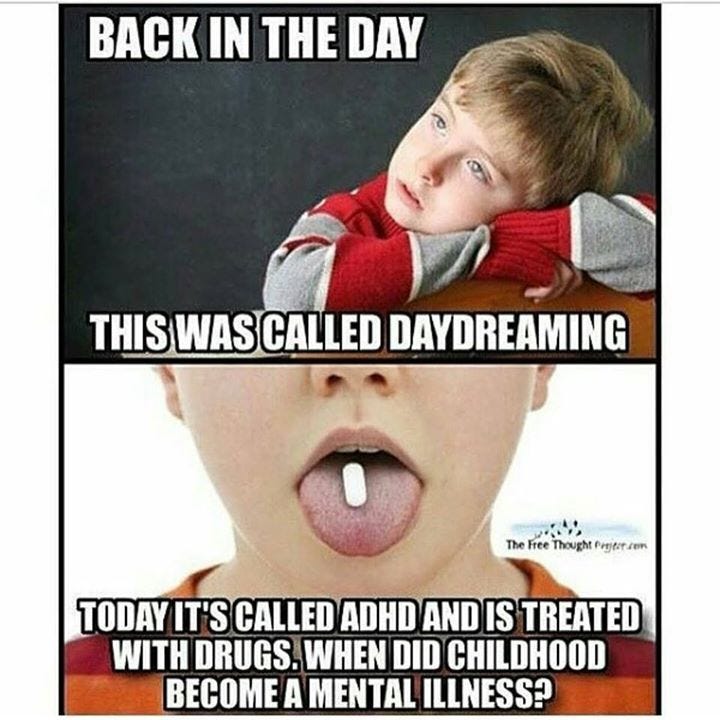I Refuse to Mourn the Death of Our Attention Spans
The "reel" grim reaper and how to prevent his untimely visit
As I walk into the waiting room of my practice to greet my next client, I'm confronted with a scene that has become all too familiar in recent years. Every face is illuminated by the soft glow of a smartphone, eyes fixated on the endless stream of content that flows before them.
I glance over at the coffee table, where a stack of magazines lies untouched, their glossy covers and bold headlines failing to compete with the allure of the digital world. It's a stark reminder of how quickly things have changed, how the once-ubiquitous waiting room staples have become relics of a bygone era. I can't help but wonder why I bother subscribing to these publications anymore, when it's clear that they hold little interest for my clients.
As I ponder the length of this article, a nagging worry consumes me. In a world where TikTok and Instagram reels dominate, where attention spans last mere seconds, can my words even compete? These algorithms have us hooked, our minds drip-fed with instant gratification, always craving more. In this ruthless fight for your focus, have I already been defeated?
"I have ADHD."
It's the new catchphrase for most clients under 35, a convenient scapegoat for any and all of life's struggles. Can't focus at work?
ADHD.
Trouble maintaining relationships?
ADHD.
Feeling overwhelmed by daily life?
You guessed it, ADHD.
The scene plays out like clockwork: clients settle onto my couch, their phones strategically placed within arm's reach, poised to pounce at the slightest vibration or flash of light. It's as if this little device has become an extension of their being, a digital appendage they can't bear to be separated from, even for a moment.
They know, on some level, that reaching for their phone during our session would be the height of rudeness, a clear violation of the unspoken therapist-client contract. And yet, when that screen illuminates, casting its seductive glow, their eyes can't help but dart in its direction, a quick, furtive glance to see who might be vying for their attention.
It's a compulsion, a knee-jerk reaction that speaks volumes about the hold these devices have over us, the way they've rewired our brains to crave that constant hit of stimulation, that never-ending stream of notifications and updates. And as I watch this scene unfold, time and time again, I can't help but wonder: How long must I maintain the illusion that my clients' struggles stem from a genetic brain disorder requiring stimulant drugs?
It's painfully obvious, yet I'm met with blank stares and offended looks when I dare to question the ADHD epidemic. Should I simply succumb to the ADHD illusion, anesthetizing my senses as I grieve the untimely demise of our collective focus?
According to a social media marketing company, the average watch time for an Instagram Reel is a mere 3 seconds.
What?
Let that sink in for a moment. In the time it takes to blink twice, the average viewer has already moved on to the next piece of content. This successful marketing company suggests the ideal Reel length for short-form videos is between 7-15 seconds.
So you have 3 seconds to grab their attention for another 4-12 seconds of full viewing.
Enough with the ADHD nonsense. Our collective attention spans have been reduced to that of a hyperactive puppy, but it's not because of some trendy disorder. The real culprit? The incessant digital distractions that bombard us from every angle, eroding our ability to focus.
I have noticed it myself. As I settle in to unwind after a grueling day, my attention fixed on a thrilling sporting event or an engrossing television show, I find myself suddenly confronted by an all-too-familiar urge.
The moment a commercial interrupts the flow of my entertainment, my hand instinctively reaches for my phone, seemingly of its own accord. Before I even realize what I'm doing, I'm already scrolling through Twitter, my eyes darting across the screen, hungrily consuming bite-sized morsels of information.
It's as if my brain, conditioned by the exposure to the rapid-fire stimuli of social media, simply cannot tolerate even a brief moment of idleness. The instant gratification of the digital world has become so deeply ingrained in our psyches that the mere prospect of sitting through a 30-second ad break feels like an unbearable test of my patience.
Now imagine being 16 years old?
Parents, I implore you: resist the temptation to seek out an ADHD diagnosis and stimulant prescription for your child. I understand the allure of a quick fix, the relief it may offer from the gnawing guilt that whispers, "It's not my fault; he has ADHD." But this label and prescription are merely a band-aid, masking the deeper issues at play.
Where Our Attention Goes Our Energy Flows
The content we consume on social media is carefully engineered to capture our attention, leveraging tactics like infinite scrolling, intermittent rewards, and algorithms that serve up more of what keeps us hooked. However, we pay a cognitive and emotional price for allowing these platforms to monopolize our attention and mental energy.
Mindlessly scrolling through a deluge of memes, viral videos, and surface-level updates provides little nourishment for the mind. Instead, it fragments our focus, diminishing our ability to tolerate boredom and engage in the deeper thinking required for creativity, problem-solving, and intellectual pursuits. The time we devote to social media's addictive streams is time traded away from reading, learning new skills, or simply being present with ourselves and our surroundings.
Moreover, the idealized self-presentations on social media can breed feelings of inadequacy, envy, and erode self-esteem, especially among young people. The momentary dopamine hits from likes and shares provide empty calories for the psyche. True fulfillment and meaning arise from investing our attention in activities that promote growth, cultivate real connections, and align with our core values - whether it's quality time with loved ones, volunteer work, creative expression, or nurturing our physical and mental health.
It's time to face reality: we've become addicted to the endless stream of bite-sized content, and it's rewiring our brains. But we can't just sit back and accept this as our inevitable fate. I refuse. We can rewire our brains to sustain attention for longer periods of time.
Since our attention spans have been collectively whittled down to mere slivers of their former selves, I'll cut to the chase and deliver these solutions in rapid-fire, bite-sized chunks that even the most distracted among us can digest.
1. Schedule Your Social Media Time.
Set specific time slots for checking social media and using your phone for non-essential purposes. Treat this allotted time as a reward after completing important tasks or during scheduled breaks. Scheduling social media time not only helps you stay focused on priorities but also prevents mindless scrolling and improves your ability to be present in the moment.
2. Time Restrictions
Many smartphone operating systems and social media applications offer tools to set daily time limits or restrict usage during certain hours. Take advantage of these features to curb excessive social media consumption. For instance, you could allow yourself 30 minutes on Instagram per day or block access to Twitter during your most productive hours. Time restrictions promote mindful social media use and prevent endless, distracting scrolling. When you hit your self-imposed limit, the app will remind you, helping you regain control over your time and attention.
3. Turn Off Notifications
Constant notifications from social media apps, emails, and other digital sources can severely disrupt your concentration and productivity. Take control by turning off all non-essential notifications on your devices. This simple step eliminates a major source of distraction, allowing you to stay immersed in your current task without the persistent temptation to check your phone or get sidetracked. Turning off notifications not only helps you maintain focus but also reduces the urge for mindless screen time and social media checking. Embrace digital silence and reclaim your attention span.
4. Social Distancing
Adopt the habit of physically separating yourself from your phone when you need to concentrate. Keep your device in another room, store it in a drawer, or simply place it out of arm's reach and sight. This simple act of "social distancing" from your phone eliminates the temptation to mindlessly check it and prevents the constant pull of distractions. When your phone is out of sight, it's easier to stay present and focused on the task at hand. By creating this physical barrier, you're less likely to succumb to the urge of picking up your device every few minutes, helping you regain control over your attention span.
5. 2 Hour Rule
Establish a rule of not using your phone or engaging with any screen for at least 2 hours before your scheduled bedtime. The blue light emitted by digital devices can suppress melatonin production, the hormone that regulates your sleep-wake cycle. By cutting off screen time well before bed, you allow your body to prepare for restful sleep naturally. Numerous studies have shown that this practice leads to improved sleep quality, helping you fall asleep faster and experience more restorative sleep cycles. Disconnecting from digital stimuli in the evening calms your mind and body, making it easier to wind down and transition into a relaxed state conducive to quality sleep.
6. Delay to Start Your Day
Instead of immediately reaching for your phone first thing in the morning, cultivate a new routine that sets a positive tone for the day. Begin by exposing yourself to natural sunlight, as it helps regulate your circadian rhythms and boost alertness. Follow this with light exercise or stretching to energize your body and mind. Then, take a few moments to practice mindfulness or meditation, allowing you to be present and centered before the day's demands kick in. This intentional morning ritual not only replaces mindless phone-scrolling but also provides numerous benefits, such as improved mood, reduced stress, and increased productivity.
7. Daily Practice
Incorporate a mindfulness or meditation practice into your daily routine, even if you start with just 5-10 minutes. Set aside a designated time, find a quiet space, and simply focus on your breath or use a guided meditation app. As you become more comfortable with the practice, gradually increase the duration. Numerous studies have demonstrated that regular meditation enhances attention span, cognitive control, and the ability to stay present. It trains your mind to resist distractions and better sustain concentration on the task at hand. Consistency is key – treating meditation like a non-negotiable appointment will help it become a habit. With time, you'll notice improved focus, reduced mind-wandering, and a greater capacity to direct your attention where you want it, leading to increased productivity and well-being.
8. Read Daily
Making time for reading, whether it's books, long-form articles, or other engaging written material, can be a powerful exercise for your brain. The act of reading requires sustained focus and attention, as you need to concentrate on the words while processing the information and allowing your mind to vividly imagine the narrative. Unlike the fragmented and distracting nature of digital content, reading encourages deep, continuous attention. As you read more consistently, you train your brain to ignore external stimuli and maintain focus for extended periods. Additionally, reading has been linked to improved cognitive abilities, including better memory retention and increased vocabulary. By incorporating reading into your daily routine, you cultivate the vital skill of concentration, ultimately enhancing your overall attention span and focus.
Don’t Join the ADHD Cult
The notion that Attention Deficit Hyperactivity Disorder (ADHD) is a valid neurological condition is more dubious than scientific. Astute critics, including myself, contend that ADHD is a socially constructed label that wrongfully pathologizes natural variations in attentional capabilities and energy levels, especially among the young.
Rather than representing an objective medical diagnosis, ADHD merely reflects society's intolerance for youthful exuberance and difficulties in sustaining focus within restrictive classroom or workplace confines. By medicalizing such natural tendencies, the ADHD diagnosis serves to uphold antiquated expectations of conformity and stillness from an age where most learning environments and occupations fail to accommodate the diverse needs of the human mind.
From this critical perspective, the ADHD label holds little legitimate explanatory value. It fallaciously implies that struggles with concentration, impulse control, and hyperactivity stem from an innate, biologically-based neurological deficit. However, as previously articulated, our attention spans are heavily influenced by environmental factors like the rise of addictive social media and ubiquitous digital technologies that actively reshape our cognitive habits.
The brain is simply operating as designed, adapting to the stimuli and demands imposed by our modern technological landscape. Rather than a disorder requiring medical intervention, difficulties in sustaining focus may be an expectable neurological response to our rapidly evolving digital world and the novel attentional demands it creates.
We can decrease our dependence on these devices and reclaim our attention spans!
This is without even discussing how nutrient deficiencies, exposure to toxins, social isolation, disconnection from nature, worrying, behavioral issues, sleep disturbances, and a sedentary lifestyle can manifest in ways that may lead school staff, mental health professionals, and medical professionals to inaccurately slap on the oversimplified label of ADHD, neglecting the complex interplay of environmental, societal, and lifestyle factors that shape attentional abilities. The ADHD label actually stops investigation into the real problems that need to be solved. Like screen and social media dependence.
The ADHD narrative conveniently aligns with the interests of pharmaceutical companies, corporate interests & serves to uphold norms around productivity, obedience, and standardized models of learning and workplace culture. Rather than a genuine health condition, ADHD represents a means of enforcing conformity and ensuring that young minds remain docile and concentrated on assigned tasks.
I refuse to mourn the supposed loss of our attention spans, nor will I comply with the dystopian vision of a humanity mindlessly and obediently addicted to screens. Our struggle to maintain focus amidst the barrage of digital stimuli is not a personal failing, but a predictable consequence of immersing our malleable minds in an unprecedented attentional landscape.
Rather than blindly accepting the ADHD narrative that commodifies our cognitive abilities, I choose to question the very systems and technologies that impose such demanding conditions on our inherently diverse neurology. We must reclaim autonomy over our attention, cultivating practices and environments that nurture depth, presence, and intentional living.









Yes yes yes! Absolutely resist and bring back common sense over pharmaceuticals.
As a second comment, this is one reason why I love substack, for the longer more engaging format possible. Although I’m digging myself into another hole by subscribing to somewhat too many at the moment, oh temptation…
This is such a great essay! Unfortunately, those who need to hear this message the most are unlikely to be willing to read it. My mid-twenties daughter did not get a smart phone until her mid-teens and went on social media without my permission. When I found out, she said that her social anxiety necessitated social media because that's the way she communicated with her few friends. Now she would not think of leaving her phone even in another room, much less going out without it. She lies in bed and scrolls in the morning and at night. It's so sad. I do not have a smart phone because I know I'd be addicted just like everyone else is. I have a Light Phone for calling and texting, and I can also listen to podcasts on it, so that's great. But I never, ever use even that phone outside because I want to be present to nature and the real world. (When I go to the doctor's office, I take a book because fewer and fewer offices even offer magazines. Most have some TV blaring but everyone just stares at their phones.) But my daughter refuses even to discuss this issue. I just don't know how to reach her and make her realize she's doing such damage to her brain and body. Fortunately, my other children are not letting their children--my grandchildren--use smartphones or even screens much. Perhaps the next generation will be different from GenZ.